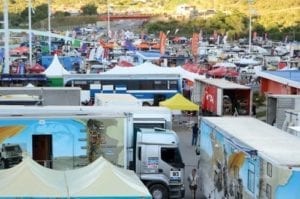Behind the scenes at the Dakar Rally is a massive machine looking after the competitors, vehicles, assistance crews, medical and catering staff, organisers, timekeepers, sponsors and media contingent.
Each day the whole Dakar ensemble – comprising 3000 people – packs up and sets off for a new destination, covering anywhere between 400 and 700 km. It is literally like creating a new city each day, and the advance crews constantly leap-frog each other to set up the infrastructure at the nominated locations for the bivouac before the first crews arrive. Covering these vast distances is no mean feat, and is strictly controlled by ASO, the organizers. ASO alone has 120 vehicles (cars, trucks and buses) on the event, including 12 helicopters and an equal number of planes.With safety a key priority, every race and assistance vehicle is fitted with a GPS unit called a Tripy. This navigation device provides point-by-point directions to get to the bivouac each day. It is also used to monitor and control the speeds of all vehicles.
A maximum speed of 110 km/h applies for the cars and bikes throughout the event on the public roads, while the trucks are restricted to 90 km/h. A 50 km/h limit is used in the cities, towns and countless villages the event passes through over the two weeks of competition. The speed limits are strictly enforced, and the Tripy flashes and beeps as soon as the posted speed is reached. ASO imposes fines ranging from 300 to 1 000 Euros depending on the nature and number of infractions, and the team’s race car could incur significant time penalties and even exclusion from the Dakar for repeated transgressions. Although this seems rather extreme, the Dakar and everyone participating in it has a huge responsibility to maintain the highest levels of safety for spectators and crews alike. This is particularly relevant considering that not one of the 35 Dakars held to date (this year is the 36th edition, although 2008 never actually started due to terrorist threats in North Africa) have been completed without the loss of life for competitors, organisers, assistance crew or spectators.







